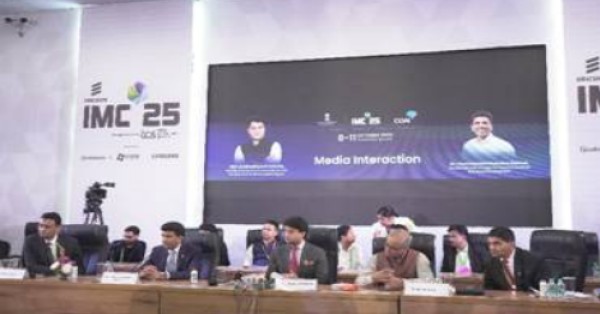India Mobile Congress 2025: India’s rise to telecom leadership
India Mobile Congress 2025 in New Delhi framed a clear ambition: scale domestic innovation, shape 6G, and turn telecom into a larger engine of GDP growth.
Scale and whole-of-government collaboration
Leaders underscored a whole-of-government approach, with multiple ministries backing IMC and the Department of Telecommunications and the Cellular Operators Association of India co-hosting. Participation spanned 400+ companies and global delegations, reflecting rising confidence in India’s role across 5G, 6G, AI-native networks, satellite communications, and quantum communications. Organizers emphasized indigenous platforms for self-reliance and export readiness, backed by a large startup cohort and closer industry–academia ties.
Why it matters now for India’s telecom
India’s telecom market has reached global scale—1.2 billion mobile subscribers and near-ubiquitous 5G district coverage—while data costs have fallen sharply over the last decade. The next cycle is about moving from access to advanced services, standards leadership, trusted infrastructure, and local manufacturing. Decisions taken in 2025–2027 will shape value capture through 6G, AI at the edge, and industry digitalization.
Economic impact: telecom GDP growth and India’s 6G dividend
Policy makers and industry chiefs put hard numbers to the opportunity, linking network evolution to productivity, exports, and IP creation.
Telecom GDP share: 12–14% to ~20% by 2037
India’s telecom and digital sector is estimated to contribute roughly 12–14% to GDP today. Leaders at IMC projected this could reach about 20% by the mid-2030s if India scales advanced connectivity, software-led services, and domestic manufacturing. The drivers include lower cost of data, wider device penetration, and enterprise digitalization in manufacturing, logistics, agriculture, and healthcare.
6G value pool and GDP uplift by 2035
India’s 6G push was tied to a potential GDP uplift exceeding a trillion dollars by 2035. The expected value comes from AI-native, deterministic networks, sensing and positioning, industrial automation, and new spectrum efficiencies. Early movers in standards, IPR, and testbeds can secure higher-margin positions in the global value chain.
Technology pillars: indigenous stacks, manufacturing, and data infrastructure
IMC highlighted progress in homegrown technology, component localization, and the data infrastructure needed for digital sovereignty.
Indigenous 4G stack and nationwide 5G coverage
India showcased a full native 4G stack assembled at scale, supported by the deployment of around 100,000 towers to strengthen coverage and resilience. The country moved from lagging on 4G to deploying 5G at record scale, with leaders citing near-complete district coverage. The stack readiness positions India to export telecom solutions to peer markets looking for cost-effective, open, and secure alternatives.
Semiconductor and electronics localization momentum
The government spotlighted progress across semiconductor incentives and electronics manufacturing schemes, with MeitY inviting capital equipment applications under the Electronics Component Manufacturing Scheme. Mobile and electronics output has expanded rapidly since 2014, and the policy focus is moving deeper into components, chipsets, and advanced packaging. The goal: reduce import dependence, build a resilient supply chain, and align domestic capacity with telecom demand cycles.
Data sovereignty and Digital Public Infrastructure (DPI)
As data volumes surge, the emphasis is on sovereign storage, trusted cross-border flows, and secure cloud and edge. India’s digital public infrastructure model continues to attract international interest, with multiple countries engaging. For telecom and cloud providers, this translates to opportunities in regional data centers, AI-ready storage, consented data exchange, and sectoral clouds for regulated industries.
6G roadmap: standards, IPR, and alliances
India’s 6G strategy is consolidating around alliances, testbeds, and global standardization participation.
Bharat 6G Alliance and global standards leadership
The Bharat 6G Alliance is aligning academia, startups, and industry to build patents and contributions into global bodies. The ambition is to raise India’s share of telecom IPR and secure essential positions in radio, RAN intelligence, devices, and edge platforms. The tie-up with GSMA leadership and engagement with global operators signal India’s intent to shape not just deployment, but the underlying rules of the game.
Research priorities and early 6G use cases
Priority areas include AI-native RAN, Open RAN evolution, NTN and satellite integration, sub-THz exploration, and network sensing. Demonstrations at IMC showcased early 6G concepts alongside AI-driven 5G applications for smart cities, precision agriculture, disaster response, and healthcare. The next milestone is translating pilots into interoperable, standards-track prototypes and pre-commercial trials.
Trust, cybersecurity, and modern regulation
Executives called out trust and safety as the industry’s next big hurdle, on par with coverage and speed.
Fraud prevention and cyber risk
Rising financial scams and cyber incidents are eroding user trust. Operators argued for stronger ecosystem collaboration to combat spoofing, identity theft, and payment fraud. End-to-end controls—SIM lifecycle integrity, real-time analytics, telco-grade identity verification, and device attestation—must complement national cyber frameworks. Fraud risk management emerged as a headline track at the event.
Regulatory modernization and spectrum roadmap
Industry leaders pressed for balanced rules that enable innovation while protecting users. Priorities include streamlined right-of-way, spectrum roadmaps for mid-band and NTN, lawful interception with privacy safeguards, and frameworks for AI governance. A modern legal foundation is seen as critical to scale enterprise 5G, FWA, edge, satellite backhaul, and converged 6G services.
Action plan for operators, vendors, and enterprises
IMC’s message was pragmatic: invest where value pools are forming and align with India’s standards and manufacturing agenda.
Network strategy: 5G SA, Open RAN, and NTN trials
Accelerate 5G Standalone, Open RAN maturity, and RIC-based optimization to lower TCO and enable network slicing. Expand FWA and private networks for industry 4.0. Start 6G-aligned trials in sensing, AI-native control, and NTN integration to build IPR and deployment muscle.
Monetization plays for enterprise verticals
Prioritize enterprise verticals with measurable ROI: logistics, manufacturing, utilities, agriculture, mining, and healthcare. Package connectivity with edge compute, computer vision, and secure data exchange. Leverage DPI rails for consented data and digital identity to ease onboarding and compliance.
Security and compliance: zero trust and sovereignty
Adopt zero trust, secure-by-design supply chains, and AI-driven fraud detection. Localize sensitive workloads to meet sovereignty requirements. Align data retention and cross-border flows with evolving policy and sectoral norms.
Ecosystem and talent: patents, startups, and open source
Engage the Bharat 6G Alliance, standards bodies, and open-source communities. Co-develop with startups through accelerators and testbeds. Build patent pipelines in RAN intelligence, device-radio co-design, and edge orchestration.
Near-term signals and policy watchlist from IMC 2025
Several triggers will determine how fast India converts momentum into measurable value.
Policy and schemes: ECMS, fabs, and spectrum calendars
Track MeitY’s ECMS traction, additional semiconductor fab announcements, spectrum calendars for 6G trials, and incentives for network equipment and optical components. Watch for updates to cyber and data frameworks affecting data center placement and edge strategy.
Industry moves: operator roadmaps and deep tech startups
Monitor Reliance Jio and Bharti Airtel roadmaps for 5G SA, Open RAN deployments, and enterprise partnerships. Follow STPI’s support for deep tech startups in AI, blockchain, IoT, and quantum. Expect stronger fraud and identity initiatives coordinated with regulators and the GSMA.
Bottom line: IMC 2025 set a clear direction—standardize early, manufacture deeper, secure the stack, and turn connectivity into productivity. Those who execute on AI-native networks, trusted data, and IP creation will capture the next decade’s telecom growth in India and beyond.








































